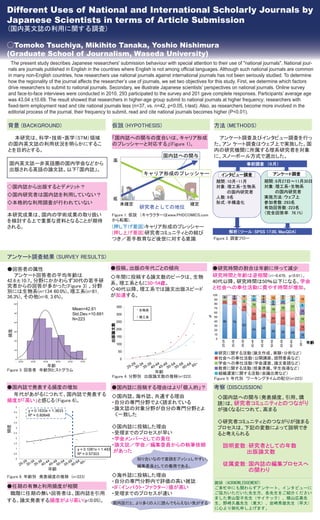
国内英文誌の利用に関する調査(2010BMB発表ポスター)
- 1. Different Uses of National and International Scholarly Journals by Japanese Scientists in terms of Article Submission (国内英文誌の利用に関する調査) ○Tomoko Tsuchiya, Mikihito Tanaka, Yoshio Nishimura (Graduate School of Journalism, Waseda University) The present study describes Japanese researchers' submission behaviour with special attention to their use of "national journals". National jour- nals are journals published in English in the countries where English is not among official languages. Although such national journals are common in many non-English countries, how researchers use national journals against international journals has not been seriously studied. To determine how the regionality of the journal affects the researcher’s use of journals, we set two objectives for this study. First, we determine which factors drive researchers to submit to national journals. Secondary, we illustrate Japanese scientists’ perspectives on national journals. Online survey and face-to-face interviews were conducted in 2010. 293 participated to the survey and 201 gave complete responses. Participants’ average age was 43.04 ±10.69. The result showed that researchers in higher-age group submit to national journals at higher frequency; researchers with fixed-term employment read and cite national journals less (n=37, vs. n=42, p<0.05, t-test). Also, as researchers become more involved in the editorial process of the journal, their frequency to submit, read and cite national journals becomes higher (P<0.01). 背景 (BACKGROUND) 仮説 (HYPOTHESIS) 方法 (METHODS) 本研究は、科学・技術・医学(STM)領域 「国内誌への関与の度合いは、キャリア形成 アンケート調査及びインタビュー調査を行っ の国内英文誌の利用状況を明らかにするこ のプレッシャーと対応する」(Figure 1)。 た。アン ケート調査はウェブ上で実施した。国 とを目的とする。 内の研究機関に所属する理系研究者を対象 国内誌への関与 に、スノーボール方式で選出した。 高 国内英文誌ー非英語圏の国内学会などから 出版される英語の論文誌。以下「国内誌」。 キャリア形成のプレッシャー ◇国内誌から出版するとデメリット? ◇国内研究者は国内誌を利用していない? 低 ◇本格的な利用調査が行われていない 未確定 確定 研究者としての地位 本研究成果は、国内の学術成果の取り扱い Figure 1. 仮説 (キャラクターはwww.PHDCOMICS.com を検討する上で重要な資料となることが期待 から転載). される。 (押し下げ要因)キャリア形成のプレッシャー (押し上げ要因)研究者コミュニティとの結び つき/若手教育など後世に対する意識 Figure 2. 調査フロー アンケート調査結果 (SURVEY RESULTS) ●回答者の属性 ●投稿、出版の年代ごとの傾向 ●研究時間の割合は年齢に伴って減少 アンケート回答者の平均年齢は ◇年間に投稿する論文数のピークは、生物 研究時間と年齢は逆相関(r=-0.470, p<0.01)。 42.6±10.7。分野にかかわらず30代の若手研 系、理工系ともに50-54歳。 40代以降、研究時間は50%以下になる。学会 究者からの回答が多かった(Figure 3) 。分野 と社会への奉仕活動に費やす時間が増加。 別には生物系(n=134 60.0%)、理工系(n=81, ◇40代以降、理工系では論文出版スピード 36.3%)、その他(n=8, 3.6%)。 が加速する。 100 6 6 6 7 6 12 5 6 90 6 7 6 5 18 6 6 6 11 11 6 11 80 14 6 9 350 19 21 16 23 Mean=42.61 70 18 18 60 Std.Dev.=10.691 300 % 50 29 12 N=223 40 80 24 32 34 18 250 78 30 63 48 18 200 20 43 頻度 35 32 29 10 18 150 0 25-29 30-34 35-39 40-44 45-49 50-54 55-59 60-64 100 65 50 ■研究に関する活動(論文作成、実験・分析など) 0 ■社会への奉仕活動(公開講座、諮問委員など) ■学会への奉仕活動(学会運営、論文査読など) 年齢 -29 0-34 5-39 0-44 5-49 0-54 5-59 0-64 65~ 25 3 3 4 4 5 5 6 ■教育に関する活動(授業準備、学生指導など) Figure 3. 回答者 年齢別ヒストグラム 年齢 ■組織運営に関する活動(会議出席など) Figure 4. 分野別 出版論文数の推移(n=223) Figure 5: 年代別 ワーキングタイムの配分(n=223) ●国内誌で発表する頻度の増加 ●国内誌に投稿する理由はより「個人的」? 考察 (DISCUSSION) 年代があがるにつれて、国内誌で発表する ◇国内誌、海外誌、共通する理由 ◇国内誌への関与(発表頻度、引用、購 頻度が「高い」と感じる(Figure 6)。 ・自分の専門分野でよく読まれている 読)は、研究者コミュニティとのつながり 5 y = 0.1533x + 1.3633 ・論文誌の対象分野が自分の専門分野とよ が強くなるにつれて、高まる 4.5 4 R² = 0.80648 く一致した 3.5 ◇研究者コミュニティとのつながりが強まる Frequency ◇国内誌に投稿した理由 頻度 3 プロセスは、下記の変数によって説明でき 2.5 ・受理までのプロセスが早い ると考えられる 2 ・学会メンバーとしての責任 1.5 ・論文誌/学会/編集委員からの執筆依頼 説明変数:研究者としての年数 1 y = 0.1081x + 1.493 0.5 R² = 0.57303 があった 出版論文数 0 知り合いなので査読をプッシュしやすい。 -29 0-34 5-39 0-44 5-49 0-54 5-59 0-64 65~ 25 3 3 4 4 5 5 6 編集委員としての義務である。 従属変数:国内誌の編集プロセスへ 年齢 の関わり Figure 6. 年齢別 発表頻度の推移 (n=223) ◇海外誌に投稿した理由 ・自分の専門分野内で評価の高い雑誌 謝辞(ACKNOWLEDGEMENT) ●任期の有無と利用頻度が相関 ・IF(インパクト・ファクター)値が高い ご多忙中にも関わらずアンケート、インタビューに 職階に任期の無い回答者は、国内誌を引用 ・受理までのプロセスが速い ご協力いただいた先生方、各先生をご紹介ください ました青山聖子先生(サイテック)、横山広美先 する、論文発表する頻度がより高い(p<0.05)。 国内誌だと、より多くの人に読んでもらえない気がする 生、野崎久義先生(東大)、岩崎秀雄先生(早大) に心より御礼申し上げます。
